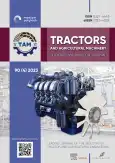Simulation model of a vehicle in the Simulink environment for determining fuel consumption in driving cycles
- Authors: Khimchenko A.V.1, Mishchenko N.I.2, Bykov V.V.2
-
Affiliations:
- Voronezh State Agrarian University named after Peter the Great
- Automobile and Road Institute of the Donetsk National Technical University
- Issue: Vol 90, No 4 (2023)
- Pages: 295-305
- Section: Environmentally friendly technologies and equipment
- URL: https://journal-vniispk.ru/0321-4443/article/view/232057
- DOI: https://doi.org/10.17816/0321-4443-322768
- ID: 232057
Cite item
Full Text
Abstract
BACKGROUND: The paper shows that the problem of determining objective indicators of fuel consumption in operation based on calculation methods remains relevant. One of these methods is simulation modeling. Current state of computer technology significantly simplifies building of system simulation models, for example, using the Simulink software by Mathworks. In the process of model development, it is necessary to keep the balance of generalization and detailing, since excessive detailing leads to an unreasonably deep consideration of individual elements of the system and to a significant increase in simulation time.
AIMS: Search for a reasonable structure of model of the “driver — car — environment” system, which makes it possible to simulate the car in driving cycles or other driving scenarios.
METHODS: The MATLAB/Simulink simulation environment was used in the study. Based on the analysis of the car design and the capabilities of individual Simulink tools, a block diagram to study fuel consumption using the example of a passenger vehicle was synthesized. The obtained model was debugged for the stable motion simulation of the vehicle in various driving cycles using graphical analysis.
RESULTS: The obtained results show that the developed system simulation model is well behaved. Control systems ensure the vehicle motion according to the mixed driving cycle modes in compliance with the required tolerances. It is possible to register fuel consumption and other simulation results of interest.
CONCLUSIONS: The model showed the relative simplicity of setting up and the ability of quick update for other vehicles. A minimal amount of vehicle data is required to bring the model to an operable condition. Particular unknown parameters are supposed to be refined using identification methods.
Full Text
##article.viewOnOriginalSite##About the authors
Arkady V. Khimchenko
Voronezh State Agrarian University named after Peter the Great
Author for correspondence.
Email: himch.arkady@yandex.ru
ORCID iD: 0000-0002-9340-4252
SPIN-code: 4568-1757
Associate Professor, Cand. Sci. (Tech.), Associate Professor of the Agricultural Machines, Tractors and Automobiles Department
Russian Federation, VoronezhNikolay I. Mishchenko
Automobile and Road Institute of the Donetsk National Technical University
Email: mim2802@mail.ru
ORCID iD: 0000-0002-0390-1563
SPIN-code: 6604-8459
Professor, Dr. Sci. (Tech.), Head of the Automobile Transportation Department
Russian Federation, GorlovkaValery V. Bykov
Automobile and Road Institute of the Donetsk National Technical University
Email: bykov_v_@mail.ru
ORCID iD: 0000-0002-4362-0053
SPIN-code: 8378-0977
Associate Professor, Cand. Sci. (Tech.), Dean of the Automobile and Road Construction Faculty
Russian Federation, GorlovkaReferences
- Andrianov AE, Maksimov VA, Pozhivilov NV. Analysis of methods for automated accounting of motor fuel consumption on city buses of the State Unitary Enterprise “Mosgortrans”. In: Problems of technical operation and auto service of rolling stock of automobile transport. Collection of scientific papers dedicated to the 85th anniversary of the MADI EATiS Department, based on the materials of the 79th scientific, methodological and research conference of MADI. Moscow; 2021:20–26. (in Russ).
- Rasporyazhenie Mintransa Rossii ot 14.03.2008 N AM-23-r (red. ot 14.07.2015). O vvede-nii v deystvie metodicheskikh rekomendatsiy «Normy raskhoda topliv i smazochnykh mate-rialov na avtomobilnom transporte». (in Russ). Accessed: 08.04.2023. Available from: https://mintrans.gov.ru/file/393913
- Boloev PA, Petrov NV, Skrybykin FA. Development of a methodology for normalizing route fuel consumption of the LIAZ-5256.57 bus in operation. Tractors and agricultural machinery. 2021;88(6):90–98. (in Russ). doi: 10.17816/0321-4443-2021-6-90-98
- Borisov GV, Leliovsky KYa, Pachurin GV. On the issue of rationing liquid fuel consumption in road transport. Fundamentalnye issledovaniya. 2015;3:28–35. (in Russ).
- Manyashin SA. Modelirovanie raskhoda topliva avtomobilyami na baze ezdovogo tsikla v nizkotemperaturnykh usloviyakh ekspluatatsii [dissertation] Orenburg; 2013. (in Russ).
- Ogorodnov SM, Zezyulin DV, Makarov VS, et al. Development of a computational and experimental methodology for estimating fuel consumption when a car moves along a given route. Sovremennye problemy nauki i obrazovaniya. 2014;4. (in Russ). Accessed: 08.04.2023. Available from: https://science-education.ru/ru/article/view?id=14280
- Sumatokhin DG. Povyshenie effektivnosti razrabotki indivi¬dualnykh marshrutnykh norm raskhoda topliva dlya gorodskikh avtobusov [dissertation] Moscow; 2012. (in Russ).
- Khimchenko AV, Mishchenko NI. Compiling the driving cycle of a car by approximating filtered experimental data using neural networks. Bulletin of the Automobile and Road Institute. 2018;4(27):3–13. (in Russ).
- Dryuchin DA, Bulatov SV, Zagidullin RR. Methodology for adjusting the standard frequency of vehicle maintenance based on data on actual fuel consumption. Intellekt. Innovatsii. Investitsii. 2022;1:93–101. (in Russ). doi: 10.25198/2077-7175-2022-1-93
- Pacejka HВ, Вesselink IJM. Magic Formula Tyre Model with Transient Properties. International Journal of Vehicle Mechanics and Mobility. 1997;27(sup001). doi: 10.1080/00423119708969658
- Besselink IJM, Schmeitz AJC, Pacejka HB. An improved Magic Formula/Swift tyre model that can handle inflation pressure changes. International Journal of Vehicle Mechanics and Mobility. 2010;48(sup1:IAVSD Supplement):337–352. doi: 10.1080/00423111003748088
- VSH Chevy-Niva. Master Motor. (in Russ). Accessed: 08.04.2023. Available from: http://www.mmotor.ru/cams/index.php?action=vsh
- Gurov MN, Moskovkin VV. Car fuel balance formula. Transport na alternativnom toplive. 2012;3(27):58–61. (in Russ).
- Gurov MN, Moskovkin VV, Egorushkin EA. Assessing the effectiveness of using various measures to reduce fuel consumption in vehicles. In: International scientific and technical conference “Informatics and technology. Innovative technologies in industry and computer science” (“MNTK FTI-2017”). Collection of scientific papers / ed. M. F. Bulatova. Moscow; 2017:189–192. (in Russ).
- Khimchenko AV, Mishchenko NI, Petrov AI, et al. Features of modeling standard road tests to determine the fuel efficiency of a car. In: Scientific and technical aspects of the development of the motor transport complex. Materials of the VΙΙΙ international scientific and practical conference “Scientific and technical aspects of the development of the motor transport complex” within the framework of the 8th International Scientific Forum of the Donetsk People’s Republic “Innovative prospects of Donbass: Infrastructural and socio-economic development”, May 25, 2022. Gorlovka; 2022:73–77. (in Russ).
Supplementary files















